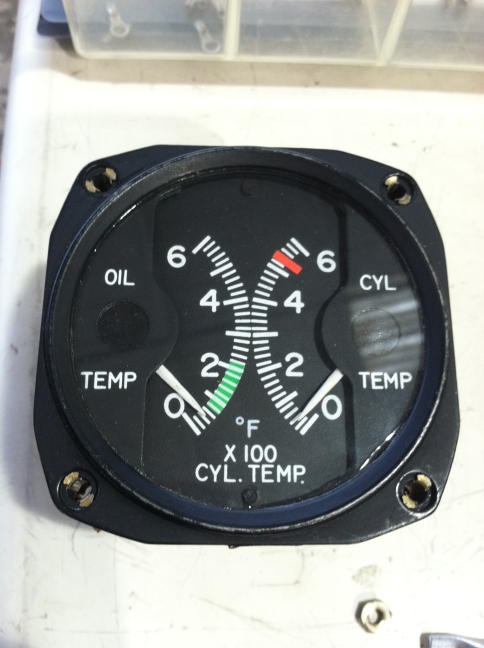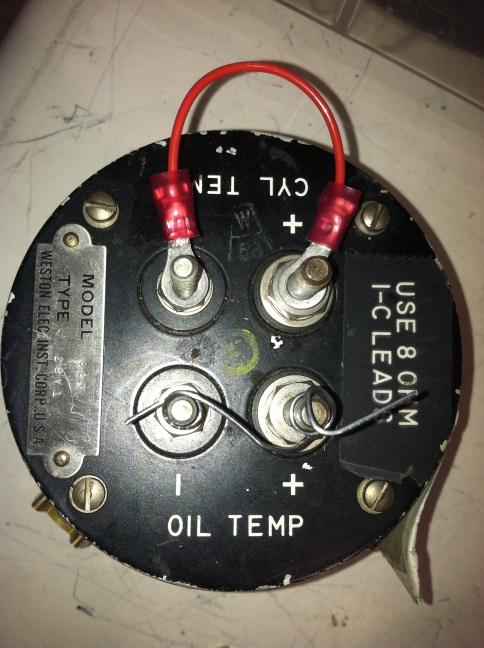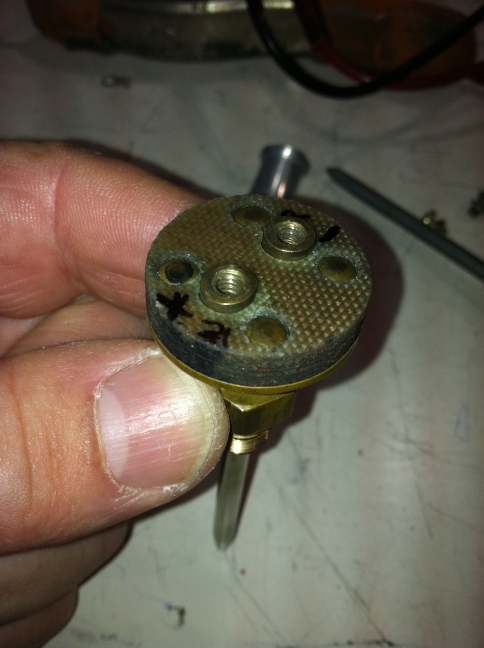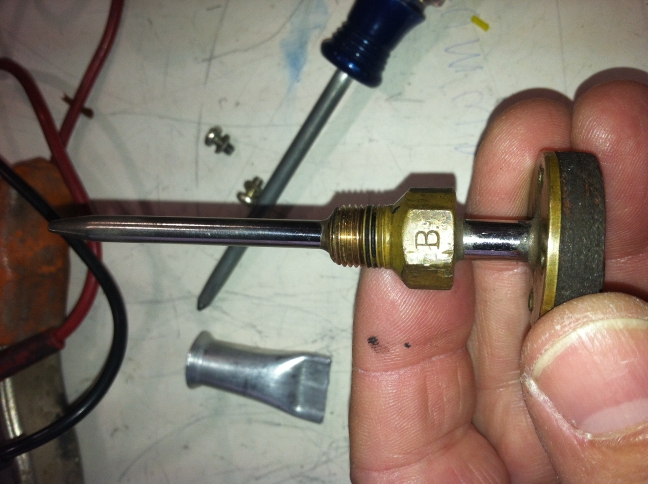 |
Matronics Email Lists
Web Forum Interface to the Matronics Email Lists
|
| View previous topic :: View next topic |
| Author |
Message |
dave.saylor.aircrafters(a
Guest
|
 Posted: Mon Dec 17, 2012 7:01 pm Post subject: Fwd: Iron-Constantan oil temp gauge Posted: Mon Dec 17, 2012 7:01 pm Post subject: Fwd: Iron-Constantan oil temp gauge |
 |
|
Bob and all:
We're working on a plane with a self-powered oil/CHT temp gauge. Â The oil side is inop, the CHT side seems to work fine. Â The customer asked us to fix the oil temp side. Â It gives no indication or needle movement at all when installed.
We removed the entire gauge, wire, and probe. Â The first problem seemed to be really poor connections so I fixed that--no help. Â Then I replaced the K type lead (as found) with J wire of about the same length. Â Still nothing.
I know now that the length of the wire is critical, but I don't know how to find what it should be. Â I see a note on the back of the gauge that says it needs to be an 8 ohm lead, but I don't know how to measure that--through the entire system, just the wire, or some combination.
Here are some pictures of the probe and the gauge.  Can you tell me what to measure to verify that the probe is working?  I've heated it up with a heat gun and a hot water bath but I don't get any comprehensible results.  Measuring mV, the multi-meter just seems to kind of wander.  About all I can say for sure is that it changes from positive to negative voltage depending on temperature, as if zero output is somewhere around room temperature.  I have seen up to about 50 mV in hot water that was about 120F but that doesn't seem consistent and it changes rapidly.
The gauge responds as I'd expect with the jumpers shorting each meter, that is, the meters lose their "bounce" with the jumpers installed.  I quickly brushed each meter's leads with an ohm meter to see if they'd respond, and they do.  Everything points to the probe.
Any advice would be much appreciated.
Dave Saylor
[url=tel:831-750-0284]831-750-0284[/url] CL
| | - The Matronics AeroElectric-List Email Forum - | | | Use the List Feature Navigator to browse the many List utilities available such as the Email Subscriptions page, Archive Search & Download, 7-Day Browse, Chat, FAQ, Photoshare, and much more:
http://www.matronics.com/Navigator?AeroElectric-List |
|
| Description: |
|
| Filesize: |
171.76 KB |
| Viewed: |
7831 Time(s) |

|
| Description: |
|
| Filesize: |
235.2 KB |
| Viewed: |
7831 Time(s) |

|
| Description: |
|
| Filesize: |
187.73 KB |
| Viewed: |
7831 Time(s) |

|
| Description: |
|
| Filesize: |
208.9 KB |
| Viewed: |
7831 Time(s) |

|
|
|
| Back to top |
|
 |
nuckolls.bob(at)aeroelect
Guest
|
 Posted: Mon Dec 17, 2012 10:29 pm Post subject: Fwd: Iron-Constantan oil temp gauge Posted: Mon Dec 17, 2012 10:29 pm Post subject: Fwd: Iron-Constantan oil temp gauge |
 |
|
At 08:59 PM 12/17/2012, you wrote:
| Quote: | Bob and all:
We're working on a plane with a self-powered
oil/CHT temp gauge. Â The oil side is inop, the
CHT side seems to work fine. Â The customer
asked us to fix the oil temp side. Â It gives no
indication or needle movement at all when installed.
We removed the entire gauge, wire, and probe. Â
The first problem seemed to be really poor
connections so I fixed that--no help. Â Then I
replaced the K type lead (as found) with J wire
of about the same length. Â Still nothing.
I know now that the length of the wire is
critical, but I don't know how to find what it
should be. Â I see a note on the back of the
gauge that says it needs to be an 8 ohm lead,
but I don't know how to measure that--through
the entire system, just the wire, or some combination.
|
This would be total loop resistance of the thermocouple
and it's leads as measured at the instrument terminals
(with the instrument disconnected).
| Quote: | Here are some pictures of the probe and the
gauge. Â Can you tell me what to measure to
verify that the probe is working? Â I've heated
it up with a heat gun and a hot water bath but I
don't get any comprehensible results. Â
Measuring mV, the multi-meter just seems to
kind of wander. Â About all I can say for sure
is that it changes from positive to negative
voltage depending on temperature, as if zero
output is somewhere around room temperature. Â I
have seen up to about 50 mV in hot water that
was about 120F but that doesn't seem consistent and it changes rapidly.
|
What resistance do you measure on the two thermocouples?
The meter scales seem to suggest that both sides have
identical movements in them. You should be able to swap
the CHT over to the OIL temp side and see an appropriate
reading. This should confirm that the thermocouple is bad.
| Quote: | The gauge responds as I'd expect with the
jumpers shorting each meter, that is, the meters
lose their "bounce" with the jumpers installed.
 I quickly brushed each meter's leads with an
ohm meter to see if they'd respond, and they do.
 Everything points to the probe.
|
Yup. Get an ohmmeter reading on the questionable
probe and compare it with the CHT side. They should
both be on the order of 8 ohms.
Bob . . .
| | - The Matronics AeroElectric-List Email Forum - | | | Use the List Feature Navigator to browse the many List utilities available such as the Email Subscriptions page, Archive Search & Download, 7-Day Browse, Chat, FAQ, Photoshare, and much more:
http://www.matronics.com/Navigator?AeroElectric-List |
|
|
|
| Back to top |
|
 |
dave.saylor.aircrafters(a
Guest
|
 Posted: Tue Dec 18, 2012 10:09 am Post subject: Fwd: Iron-Constantan oil temp gauge Posted: Tue Dec 18, 2012 10:09 am Post subject: Fwd: Iron-Constantan oil temp gauge |
 |
|
On Mon, Dec 17, 2012 at 10:28 PM, Robert L. Nuckolls, III <nuckolls.bob(at)aeroelectric.com (nuckolls.bob(at)aeroelectric.com)> wrote:
| Quote: | --> AeroElectric-List message posted by: "Robert L. Nuckolls, III" <nuckolls.bob(at)aeroelectric.com (nuckolls.bob(at)aeroelectric.com)>
At 08:59 PM 12/17/2012, you wrote:
| Quote: | Bob and all:
We're working on a plane with a self-powered oil/CHT temp gauge. Ã The oil side is inop, the CHT side seems to work fine. Ã The customer asked us to fix the oil temp side. Ã It gives no indication or needle movement at all when installed.
We removed the entire gauge, wire, and probe. Ã The first problem seemed to be really poor connections so I fixed that--no help. Ã Then I replaced the K type lead (as found) with J wire of about the same length. Ã Still nothing.
I know now that the length of the wire is critical, but I don't know how to find what it should be. Ã I see a note on the back of the gauge that says it needs to be an 8 ohm lead, but I don't know how to measure that--through the entire system, just the wire, or some combination.
|
 This would be total loop resistance of the thermocouple
 and it's leads as measured at the instrument terminals
 (with the instrument disconnected).
| Quote: | Here are some pictures of the probe and the gauge. à Can you tell me what to measure to verify that the probe is working? à I've heated it up with a heat gun and a hot water bath but I don't get anyà comprehensibleà results. à Measuringà mV, the multi-meter just seems to kind of wander. à About all I can say for sure is that it changes from positive to negative voltage depending on temperature, as if zero output is somewhere around room temperature. à I have seen up to about 50 mV in hot water that was about 120F but that doesn't seem consistent and it changes rapidly.
|
 What resistance do you measure on the two thermocouples?
|
| Quote: | Â The meter scales seem to suggest that both sides have
 identical movements in them. You should be able to swap
 the CHT over to the OIL temp side and see an appropriate
 reading. This should confirm that the thermocouple is bad.
| Quote: | The gauge responds as I'd expect with the jumpers shorting each meter, that is, the meters lose their "bounce" with the jumpers installed. à Ià quicklyà brushed each meter's leads with an ohm meter to see if they'd respond, and they do. à Everything points to the probe.
|
 Yup. Get an ohmmeter reading on the questionable
 probe and compare it with the CHT side. They should
 both be on the order of 8 ohms.
 Bob . . .
|
The functioning thermocouple is the type that goes under a spark plug. Â It measures 6 ohms one way, 4 ohms the other way, including the lead.
The other thermocouple is "nearly open"... very high resistance, 500K one way, 300K the other way.
Â
That was the part of the puzzle I needed. Â Now I know what to replace.
Something I'm still trying to understand is how the meter can measure a voltage when the junction itself seems to be perfectly grounded to the airframe.  For example, the surface of the metallic CHT ring under the spark plug ohms out to the end of the lead at the instrument, telling me it's essentially a dead short from the contact with the spark plug, or oil temp sender, or any other junction, to ground. Is it just the potential at the junction that matters, and the mechanical connection is required to move the heat to the junction?  That's all I can figure.
Many thanks,
Dave Saylor
[url=tel:831-750-0284]831-750-0284[/url] CL
[quote][b]
| | - The Matronics AeroElectric-List Email Forum - | | | Use the List Feature Navigator to browse the many List utilities available such as the Email Subscriptions page, Archive Search & Download, 7-Day Browse, Chat, FAQ, Photoshare, and much more:
http://www.matronics.com/Navigator?AeroElectric-List |
|
|
|
| Back to top |
|
 |
nuckollsr
Joined: 24 Mar 2009
Posts: 95
Location: Medicine Lodge, KS
|
 Posted: Thu Dec 20, 2012 8:17 pm Post subject: Re: Fwd: Iron-Constantan oil temp gauge Posted: Thu Dec 20, 2012 8:17 pm Post subject: Re: Fwd: Iron-Constantan oil temp gauge |
 |
|
Gee Dave. if you'd been sitting out with the rest of the class last time I was there . . . seriously tho . . . that was some time ago.
Thermocouples are a unique kind of voltage source with a very low source impedance. I.e. the source impedance is equal to that of the wires which make up the thermocouple. In the present case, we're talking about type-K (iron-constantan) wire-couple. See:
www.aeroelectric.com/articles/excerpt.pdf
Those readings sound like resistances from the instrument end of one wire to the plug washer . . . If you measured beween the two wires at the instrument end, you would get 10 ohms . . . in the ball park for a properly working thermocouple. To make ACCURATE low resistance measurements you need something like the precision low resistance adapter on my website or some similar 4-wire ohmmeter.
In any case, the slightly too-high reading you got is consistent with such lo-ohms readings at the ends of ordinary test leads.
The thermocouple you have may be repairable. I've fixed a number of them that became 'open' right where the two wires crimp into the plug washer. I trim the wire back, strip ends, silver-solder together and then tack silver-solder the junction back onto the tang of the plug washer.
| | - The Matronics AeroElectric-List Email Forum - | | | Use the List Feature Navigator to browse the many List utilities available such as the Email Subscriptions page, Archive Search & Download, 7-Day Browse, Chat, FAQ, Photoshare, and much more:
http://www.matronics.com/Navigator?AeroElectric-List |
|
|
|
| Back to top |
|
 |
dave.saylor.aircrafters(a
Guest
|
 Posted: Thu Dec 20, 2012 10:42 pm Post subject: Fwd: Iron-Constantan oil temp gauge Posted: Thu Dec 20, 2012 10:42 pm Post subject: Fwd: Iron-Constantan oil temp gauge |
 |
|
What can I say...the old neurons need the rust busted off just like an iron wire now and then. Â At least I didn't ask about parasitic junctions--that I remembered from your seminar, and I use that little tidbit every time we install the eight to 14 thermocouples on most of the engines we wire.
The thermocouple that failed (the one in the picture) is a probe type that threads into the oil screen housing.
Once I realized it was terminal, I took it apart. Â The iron wire was badly corroded and literally fell out of the probe body onto my workbench.
It was covered with thick red rust.
The other wire was firmly attached inside at the tip of the probe. Â I don't see any practical way to reattach an iron wire inside the tube of the probe so I'm open to suggestions. Â I'll probably try to find something similar to replace it.
It's not surprising that the iron corroded. Â It got a hot/cold cycle on each engine run, and it was by no means sealed from the atmosphere. Â On every warming it drove out the air in the tube and on every cooldown it pulled in whatever was outside. Â It took 65 years, but it finally gave up the ghost.
Dave Saylor
831-750-0284 CL
On Thu, Dec 20, 2012 at 8:17 PM, nuckollsr <bob.nuckolls(at)aeroelectric.com (bob.nuckolls(at)aeroelectric.com)> wrote:
[quote] --> AeroElectric-List message posted by: "nuckollsr" <bob.nuckolls(at)aeroelectric.com (bob.nuckolls(at)aeroelectric.com)>
Gee Dave. if you'd been sitting out with the rest of the class last time I was there . . . seriously tho . . . that was some time ago.
Thermocouples are a unique kind of voltage source with a very low source impedance. I.e. the source impedance is equal to that of the wires which make up the thermocouple. In the present case, we're talking about type-K (iron-constantan) Â wire-couple. See:
www.aeroelectric.com/articles/excerpt.pdf
Those readings sound like resistances from the instrument end of one wire to the plug washer . . . If you measured beween the two wires at the instrument end, you would get 10 ohms . . . in the ball park for a properly working thermocouple. To make ACCURATE low resistance measurements you need something like the precision low resistance adapter on my website or some similar 4-wire ohmmeter.
In any case, the slightly too-high reading you got is consistent with such lo-ohms readings at the ends of ordinary test leads.
The thermocouple you have may be repairable. I've fixed a number of them that became 'open' right where the two wires crimp into the plug washer. Â I trim the wire back, strip ends, silver-solder together and then tack silver-solder the junction back onto the tang of the plug washer.
Read this topic online here:
http://forums.matronics.com/viewtopic.php?p=390768#390768
===========
target="_blank">www.aeroelectric.com
ldersbooks.com" target="_blank">www.buildersbooks.com
" target="_blank">www.homebuilthelp.com
t="_blank">http://www.matronics.com/contribution
     -Matt Dralle, List Admin.
===========
-
ric-List" target="_blank">http://www.matronics.com/Navigator?AeroElectric-List
===========
MS -
k">http://forums.matronics.com
===========
[b]
| | - The Matronics AeroElectric-List Email Forum - | | | Use the List Feature Navigator to browse the many List utilities available such as the Email Subscriptions page, Archive Search & Download, 7-Day Browse, Chat, FAQ, Photoshare, and much more:
http://www.matronics.com/Navigator?AeroElectric-List |
|
|
|
| Back to top |
|
 |
mrspudandcompany(at)veriz
Guest
|
 Posted: Fri Dec 21, 2012 6:42 am Post subject: Fwd: Iron-Constantan oil temp gauge Posted: Fri Dec 21, 2012 6:42 am Post subject: Fwd: Iron-Constantan oil temp gauge |
 |
|
It's not surprising that the iron corroded. Â It got a hot/cold cycle on each engine run, and it was by no means sealed from the atmosphere. Â On every warming it drove out the air in the tube and on every cooldown it pulled in whatever was outside. Â It took 65 years, but it finally gave up the ghost.
[quote] Dave
Perhaps, since it lasted such a short time, you could get it replaced under warranty 
Roger
Do not archive
[b]
| | - The Matronics AeroElectric-List Email Forum - | | | Use the List Feature Navigator to browse the many List utilities available such as the Email Subscriptions page, Archive Search & Download, 7-Day Browse, Chat, FAQ, Photoshare, and much more:
http://www.matronics.com/Navigator?AeroElectric-List |
|
|
|
| Back to top |
|
 |
nuckollsr
Joined: 24 Mar 2009
Posts: 95
Location: Medicine Lodge, KS
|
 Posted: Fri Dec 21, 2012 6:47 pm Post subject: Re: Fwd: Iron-Constantan oil temp gauge Posted: Fri Dec 21, 2012 6:47 pm Post subject: Re: Fwd: Iron-Constantan oil temp gauge |
 |
|
Send me the probe if you like. I can probably refurbish it.
Bob . . .
| | - The Matronics AeroElectric-List Email Forum - | | | Use the List Feature Navigator to browse the many List utilities available such as the Email Subscriptions page, Archive Search & Download, 7-Day Browse, Chat, FAQ, Photoshare, and much more:
http://www.matronics.com/Navigator?AeroElectric-List |
|
|
|
| Back to top |
|
 |
nuckollsr
Joined: 24 Mar 2009
Posts: 95
Location: Medicine Lodge, KS
|
 Posted: Fri Dec 21, 2012 6:50 pm Post subject: Re: Fwd: Iron-Constantan oil temp gauge Posted: Fri Dec 21, 2012 6:50 pm Post subject: Re: Fwd: Iron-Constantan oil temp gauge |
 |
|
Actually Dave, that thread looks like 1/4"NPT, give me the length below the threads and I can make a whole new probe.
Bob. . .
| | - The Matronics AeroElectric-List Email Forum - | | | Use the List Feature Navigator to browse the many List utilities available such as the Email Subscriptions page, Archive Search & Download, 7-Day Browse, Chat, FAQ, Photoshare, and much more:
http://www.matronics.com/Navigator?AeroElectric-List |
|
|
|
| Back to top |
|
 |
millner(at)me.com
Guest
|
 Posted: Sat Dec 22, 2012 1:36 pm Post subject: Fwd: Iron-Constantan oil temp gauge Posted: Sat Dec 22, 2012 1:36 pm Post subject: Fwd: Iron-Constantan oil temp gauge |
 |
|
On 12/20/2012 8:17 PM, nuckollsr wrote:
| Quote: | In the present case, we're talking about type-K (iron-constantan) wire-couple
|
Don't think so... Type J is iron-constantan. Type K is chromel-alumel, no?
Paul
| | - The Matronics AeroElectric-List Email Forum - | | | Use the List Feature Navigator to browse the many List utilities available such as the Email Subscriptions page, Archive Search & Download, 7-Day Browse, Chat, FAQ, Photoshare, and much more:
http://www.matronics.com/Navigator?AeroElectric-List |
|
|
|
| Back to top |
|
 |
millner(at)me.com
Guest
|
 Posted: Sat Dec 22, 2012 2:13 pm Post subject: Fwd: Iron-Constantan oil temp gauge Posted: Sat Dec 22, 2012 2:13 pm Post subject: Fwd: Iron-Constantan oil temp gauge |
 |
|
On 12/20/2012 8:17 PM, nuckollsr wrote:
| Quote: | In the present case, we're talking about type-K (iron-constantan) wire-couple
|
Don't think so... Type J is iron-constantan. Type K is chromel-alumel, no?
Paul
| | - The Matronics AeroElectric-List Email Forum - | | | Use the List Feature Navigator to browse the many List utilities available such as the Email Subscriptions page, Archive Search & Download, 7-Day Browse, Chat, FAQ, Photoshare, and much more:
http://www.matronics.com/Navigator?AeroElectric-List |
|
|
|
| Back to top |
|
 |
nuckolls.bob(at)aeroelect
Guest
|
 Posted: Sat Dec 22, 2012 2:27 pm Post subject: Fwd: Iron-Constantan oil temp gauge Posted: Sat Dec 22, 2012 2:27 pm Post subject: Fwd: Iron-Constantan oil temp gauge |
 |
|
At 03:34 PM 12/22/2012, you wrote:
| Quote: |
On 12/20/2012 8:17 PM, nuckollsr wrote:
>In the present case, we're talking about type-K
>(iron-constantan) wire-couple
Don't think so... Type J is iron-constantan. Type K is chromel-alumel, no?
|
Ah yes . . . but of course . . . thanks for saving me from stepping off
into that hole!
Dave, what colors the insulation on your thermocouple leads.
"Most" folks follow the convention for Type J wire (Iron
Constantan) to have red and white insulation on the individual
strands.
http://tinyurl.com/cutt7qu
The Type K wire (Chromel-Alumel) strands are usually
yellow and red.
http://tinyurl.com/cgz6yxe
I think one of the reasons that Type-J wire is
not favored for long term installation is vulnerablity
to corrosion for the iron wire. If the probe you have
did indeed rust through one of the conductors,
it seems likely that your working with J wire, not
K.
In fact, I note that the back of your gage is marked
for 8 ohm, I-C leads. I think you mentioned that earlier
but it got stuck in a transient short between the headphones.
This page on Omega.com will let you order 25' of
GG-J-20S wire for about $32. I think I'd use new
wire and fabricate a new probe from scratch.
Silver solder a piece of stainless tube into a
suitable brass pipe plug. Fabricate a thermocouple
with a few twists of bared conductor and capture them
into the deep end of the tube by mashing in a vice.
Then silver solder the deep end of the probe shut.
According to this table
http://tinyurl.com/d8c67e7
The loop resistance for 20 gage stranded type J wire
is .348 ohms per foot. An 8-ohm probe lead would require
all of the 25 feet. Were your old leads that long?
The they were originally 22AWG, then the overall
length would have been about 16'
Alternatively, you could use a shorter lead set
up to require a precision low-ohms resistor. For
example, a 10' lead set of 20S I-C wire would have
a resistance on the order of 3.5 ohms . . . so you'd
want to insert an additional 4.5 ohms in series with
one lead. Yeah, this creates some parasitic
thermocouples but they are opposing pairs in close
thermal proximity.
Self powered thermocouple instruments for large
airplanes used to always require calibration resistors.
This let you use a common instrument and probes
for all 4 engines while offering a way to compensate
for different installed lengths of thermocouple wire.
Bob . . .
| | - The Matronics AeroElectric-List Email Forum - | | | Use the List Feature Navigator to browse the many List utilities available such as the Email Subscriptions page, Archive Search & Download, 7-Day Browse, Chat, FAQ, Photoshare, and much more:
http://www.matronics.com/Navigator?AeroElectric-List |
|
|
|
| Back to top |
|
 |
|
|
You cannot post new topics in this forum
You cannot reply to topics in this forum
You cannot edit your posts in this forum
You cannot delete your posts in this forum
You cannot vote in polls in this forum
You cannot attach files in this forum
You can download files in this forum
|
Powered by phpBB © 2001, 2005 phpBB Group
|






